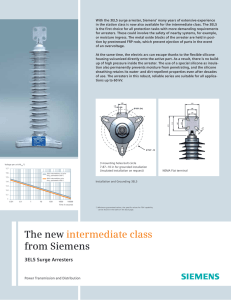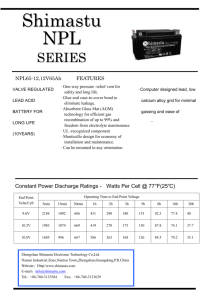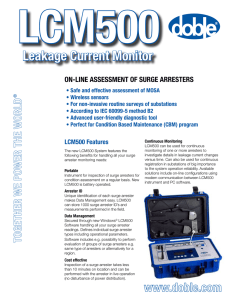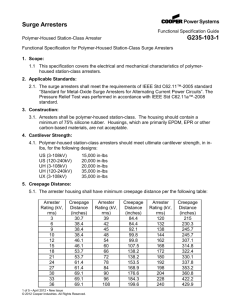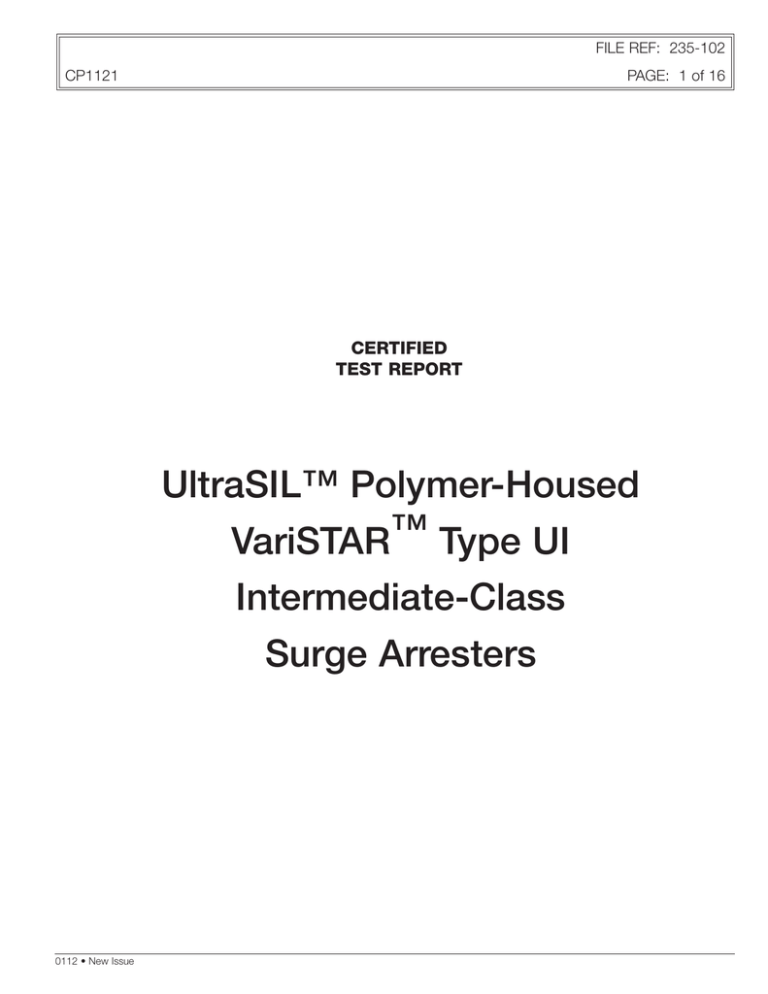
FILE REF: 235-102
CP1121
PAGE: 1 of 16
Certified
Test Report
UltraSIL™ Polymer-Housed
VariSTAR™ Type UI
Intermediate-Class
Surge Arresters
0112 • New Issue
FILE REF: 235-102
CP1121
PAGE: 2 of 16
UltraSIL™ Polymer-Housed
VariSTAR™ Type UI
Intermediate-Class Surge Arresters
CERTIFICATION
Statements made and data shown are, to the best of our knowledge and belief,
correct and within the usual limits of commercial testing practice.
Chuck Daley
Staff Engineer
Michael M. Ramarge
Manager of Product Engineering - Arresters
FILE REF: 235-102
CP1121
PAGE: 3 of 16
INTRODUCTION
This test report certifies that the UltraSIL Polymer-Housed VariSTAR Type UI Intermediate-Class Surge Arresters were successfully tested to IEEE Std C62.11™-2005 standard "IEEE Standard for Metal-Oxide Surge Arresters for Alternating Current Power
Circuits". The Pressure Relief Test was performed in accordance with IEEE Std C62.11a™-2008.
TEST PROGRAM
OBJECT
To demonstrate that the UltraSIL Polymer-Housed VariSTAR Type UI Intermediate-Class Surge Arresters meet all performance
requirements.
PROCEDURE
The following design tests were performed on a sufficient number of samples to demonstrate all performance requirements
are met.
DESIGN TESTS
A. Insulation Withstand . . . . . . . . . . . . . . . . . . . . . . . . . . . . . . . . . . Per IEEE Std C62.11™-2005 standard, Section 8.1.2.4
B. Discharge Voltage Current Characteristics . . . . . . . . . . . . . . . Per IEEE Std C62.11™-2005 standard, Section 8.3.1
C.Discharge Voltage Time Characteristics . . . . . . . . . . . . . . . . . Per IEEE Std C62.11™-2005 standard, Section 8.4
D. Accelerated Aging Procedure . . . . . . . . . . . . . . . . . . . . . . . . . Per IEEE Std C62.11™-2005 standard, Section 8.5
E. High-Current, Short-Duration . . . . . . . . . . . . . . . . . . . . . . . . . Per IEEE Std C62.11™-2005 standard, Section 8.12
F. Transmission-Line Discharge Test . . . . . . . . . . . . . . . . . . . . . . . Per IEEE Std C62.11™-2005 standard, Section 8.13.1
G.Duty Cycle . . . . . . . . . . . . . . . . . . . . . . . . . . . . . . . . . . . . . . . Per IEEE Std C62.11™-2005 standard, Section 8.14
H.Short Circuit Test (Design B) . . . . . . . . . . . . . . . . . . . . . . . . . . Per IEEE Std C62.11a™-2008 standard, Section 8.21
I. Contamination Test . . . . . . . . . . . . . . . . . . . . . . . . . . . . . . . . . Per IEEE Std C62.11™-2005 standard, Section 8.8
J. Temporary Overvoltage (TOV) . . . . . . . . . . . . . . . . . . . . . . . . . Per IEEE Std C62.11™-2005 standard, Section 8.15
K. Accelerated Aging Tests by Exposure to Salt Fog . . . . . . . . . . Per IEEE Std C62.11™-2005 standard, Section 8.7
L. Maximum Design Cantilever Test for Polymer-Housed Arresters
. . . . . . . . . . . . . . . . . . . . . . . . . . . . . . . . . . . . . . . . . . . . . . . . Per IEEE Std C62.11™-2005 standard, Section 8.22
M.Moisture Ingress Test for Polymer-Housed Arresters . . . . . . . . Per IEEE Std C62.11™-2005 standard, Section 8.22
N.Partial Discharge (PD) Test . . . . . . . . . . . . . . . . . . . . . . . . . . . Per IEEE Std C62.11™-2005 standard, Section 8.11
RESULTS
UltraSIL Polymer-Housed VariSTAR Type UI Intermediate-Class Surge Arresters met all performance requirements.
FILE REF: 235-102
CP1121
PAGE: 4 of 16
TEST A
INSULATION WITHSTAND
OBJECT
To verify that the assembled insulating members of the VariSTAR Type UI Intermediate-Class Surge Arresters withstand impulse
and power fre­quen­cy voltage tests.
PROCEDURE
• For each arrester rating the maximum 8 x 20, 20 kA discharge voltage was determined. This value was multiplied by a factor
of 1.42. This calculated value established the minimum 1.2 x 50 µs impulse withstand level.
• New, clean arrester samples of each rating, with internal parts removed, were subjected to positive and negative 1.2 x 50
µs voltage impulses which exceeded the minimum withstand levels as calculated above.
• For each arrester rating, the maximum switching impulse discharge voltage was determined. This value was multiplied by a
factor of 0.82. This calculated value established the minimum 10 second, wet 60 Hz withstand voltage in rms volts for each
arrester.
• Arrester samples of each rating having the internal parts removed, were wetted and subjected to 10 seconds of 60 Hz rms
voltages exceeding the minimum withstand voltages as calculated above.
RESULTS
The samples did not flash over during the tests performed. Table 1 shows the insulation withstand voltages for VariSTAR Type
UI Intermediate-Class Surge Arresters.
TEST B
DISCHARGE VOLTAGE CURRENT CHARACTERISTICS
OBJECT
To determine the maximum discharge voltage char­ac­ter­is­tics of the VariSTAR Type UI Intermediate-Class Surge Arresters at
1.5, 3, 5, 10, 20 and 40 kA crest.
PROCEDURE
• Sample arresters were impulsed using an 8 x 20 µs wave shape at 1.5, 3, 5, 10, 20 and 40 kA crest.
• The discharge voltage crest was measured.
RESULTS
Chart 2 shows the maximum 8 x 20 discharge voltages for the VariSTAR Type UI Intermediate-Class Surge Arresters.
FILE REF: 235-102
CP1121
PAGE: 5 of 16
TEST C
DISCHARGE VOLTAGE TIME CHARACTERISTICS
OBJECT
To obtain the front-of-wave and switching impulse protective levels of the VariSTAR Type UI Intermediate-Class Surge
Arresters.
PROCEDURE
Front-of-Wave Protective Level:
• A current of 10 kA was used to determine the front-of-wave protective level.
• The arresters were impulsed using front times of 8 µs, 2 µs and 1 µs.
• The maximum discharge voltage and the time to voltage crest were measured.
• The voltage/time measurements were plotted on linear voltage versus log time paper and the maxi­mum voltage at 0.5 µs
was determined.
Switching Impulse Protective Level:
• Currents of 500 A crest were used to determine the switching impulse protective level.
• The arresters were impulsed with switching impulse current waves having a time to actual crest of 45 to 60 µs.
• The discharge voltage crest was measured.
RESULTS
Table 2 shows the front-of-wave and switching impulse protective levels for the VariSTAR Type UI Intermediate-Class Surge
Arresters.
TEST D
ACCELERATED AGING PROCEDURE
OBJECT
To verify the KC and KR ratios of the VariSTAR Type UI Intermediate-Class Surge Arresters.
KC = MCOV Ratio
KR = Duty Cycle Ratio
These ratios were determined to calculate the test values of MCOV and duty cycle voltages used during testing.
PROCEDURE
• Samples were placed in an oven at 115 °C and energized at MCOV for 1,000 hours.
• The watts loss was measured at the MCOV and duty cycle voltage levels within two to five hours after the start of the test.
• The watts loss was remeasured at 1,000 hours at MCOV and duty cycle voltage levels.
• KC = Watts Loss @ 1,000 Hrs @ MCOV
Watts Loss @ 2-5 Hrs @ MCOV
• KR = Watts Loss @ 1,000 Hrs @ Rated Voltage
Watts Loss @ 2-5 Hrs @ Rated Voltage
• If KC and KR ≤ 1, then KC and KR are equal to 1.
RESULTS
KC and KR = 1.
FILE REF: 235-102
CP1121
PAGE: 6 of 16
TEST E
HIGH-CURRENT, SHORT-DURATION
OBJECT
To demonstrate that the VariSTAR Type UI Intermediate-Class Surge Arresters meet the high-current, short-duration
requirements.
KW = Watts Loss Ratio
PROCEDURE
• Three prorated equivalent thermal sections were used for this test.
• Each sample was impulsed with a 100 kA crest current with a wave shape of 4 x 10 µs. This exceeded the required peak
current of 65 kA.
• The samples were allowed to cool to ambient temperature.
• Each sample was impulsed a second time.
• Immediately following the second impulse, the samples were energized at the thermal recovery voltage equivalent to
MCOV x KW x KC for 30 minutes to verify thermal recovery.
• The samples were inspected after testing to verify that there was no physical damage.
• KW = Voltage at max watts/MCOV
RESULTS
VariSTAR Type UI Intermediate-Class Surge Arresters met the high-cur­rent, short-duration requirements of two impulses,
ther­mal recovery, and no physical damage.
TEST F
TRANSMISSION-LINE DISCHARGE TEST
OBJECT
To demonstrate that the VariSTAR Type UI Intermediate-Class Surge Arresters meet the transmission-line discharge test.
PROCEDURE
• Three prorated equivalent thermal sections were used for this test.
• Each sample was impulsed with a 10 kA crest, 8 x 20 µs wave and the discharge voltage was measured.
• Each sample was subjected to three groups of six consecutive Transmission-Line Discharge (TLD) operations timed to
occur 50 to 60 seconds apart.
• The samples were permitted to cool after each group of six impulses.
• After the 18th impulse the samples were heated to 60 degrees centigrade and allowed to thermally stabilize.
• Within two minutes upon removal from the oven, two additional TLD impulses were applied 50 to 60 seconds apart.
• Within one minute the appropriate 60 Hz voltage was applied and the watts loss was monitored for a minimum of 30
minutes to verify thermal recovery.
• Each sample was subjected to a final 10 kA crest, 8 x 20 µs impulse wave and the discharge voltage measured. The
discharge voltage was compared to the discharge voltage taken prior to duty cycle to make sure that it did not vary by
more than ±10%.
• The samples were inspected after testing to assure that no physical damage occurred.
RESULTS
VariSTAR Type UI Intermediate-Class Surge Arresters met the Transmission-Line Discharge test requirements of 20 impulses,
less than 10% change in discharge voltage, and no physical damage.
FILE REF: 235-102
CP1121
PAGE: 7 of 16
TEST G
DUTY CYCLE
OBJECT
To demonstrate that the VariSTAR Type UI Intermediate-Class Surge Arresters meet duty cycle requirements.
PROCEDURE
• Three prorated equivalent thermal sections were used for this test.
• Each sample was impulsed with 10 kA crest, 8 x 20 µs wave and the dis­charge voltage mea­sured.
• Each sample was energized at KR times the duty cycle voltage (KR = 1), for the duration of time needed to allow 20 im­puls­es.
• Each sample was impulsed with 10 kA crest surges of 8 x 20 µs wave shape.
• Each impulse occurred at approximately 60° before the crest on the power frequency wave.
• Each sample was impulsed once every 50 to 60 seconds for 20 consecutive impulses.
• After the 20th impulse, the samples were de-energized and placed into an oven until they stabilized at 60 °C.
• Each sample was removed from the oven and immediately energized at KC times the MCOV (KC = 1) and impulsed twice
more with a 10 kA crest, 8/20 µs wave within one minute.
• Samples remained energized at the thermal recovery voltage equivalent to MCOV x KW x KC for 30 minutes min­i­mum to
verify thermal recovery.
• Each sample was then impulsed with a 10 kA crest, 8 x 20 µs wave and the discharge voltage mea­sured. The discharge
voltage was compared to the discharge volt­age taken prior to duty cycle to make sure that it did not vary by more than ±
10%.
• The samples were inspected after testing to assure that no physical damage occurred.
RESULTS
VariSTAR Type UI Intermediate Class Surge Arresters met the duty cycle test requirements of 22 impulses, thermal recovery,
less than 10% change in discharge voltage, and no physical damage.
TEST H
Short Circuit Test
(Design B)
OBJECT
To verify arrester internal fault is not likely to create an explosive event in accordance with IEEE Std C62.11a™-2008
standard.
PROCEDURE
• Samples were prefailed by power frequency overvoltage.
• 60 kV rated samples were used in this testing (the highest voltage rating in a single unit housing).
• The arrester samples were mounted to simulate service conditions.
High-Current Short Circuit Testing:
• The test circuit was adjusted to produce a 60 Hz, 40 kA (rms) current for a minimum of 0.2 seconds.
• The above noted current was initiated within 5° of the applied 60 Hz voltage zero.
• The arresters were monitored to assure venting occurred without violent shattering.
Low-Current Short Circuit Testing:
• Samples were prefailed by power frequency overvoltage.
• The test circuit was adjusted to produce a 60 Hz current of 600 A determined by the average for the duration of the current
flow.
• The current duration lasted until the arrester vented up to a maximum of 1 second or until venting occurred.
RESULTS
VariSTAR Type UI Intermediate-Class Surge Arresters passed the described high and low-current tests based on
oscillograph recordings showing test current magnitude and duration, from the evidence of the time at which the venting
occurred, and from the confinement of all components of the arrester within the specified enclosures.
FILE REF: 235-102
CP1121
PAGE: 8 of 16
TEST I
CONTAMINATION TEST
OBJECT
To demonstrate the ability of the VariSTAR Type UI Intermediate-Class Surge Arresters to withstand the electrical stresses
caused by contamination on the housing.
PROCEDURE
• 108 kV samples were used in this test.
• Arrester samples were energized for a minimum of one hour at MCOV.
• The watts loss at MCOV was measured at the end of the hour.
• The samples were de-energized. Within 13 minutes, a 400-500 Ωcm slurry was applied to the lower half of the arrester
housing heavily enough to form drops on the skirts.
• The samples were energized at the MCOV voltage.
• The watts loss was measured after 15 minutes.
• The samples were de-energized again and another slurry application was performed.
• The samples were energized at MCOV for 30 minute intervals and the watts loss was monitored to verify decreasing levels
towards the original measurement.
• Once the samples were cleaned and dried, they were inspected for internal damage using partial discharge measurements
at MCOV.
RESULTS
VariSTAR Type UI Intermediate-Class Surge Arrester samples passed the test by having stabilized lower watts loss over time,
by not flashing over and by not having any internal physical damage.
FILE REF: 235-102
CP1121
PAGE: 9 of 16
TEST J
TEMPORARY OVERVOLTAGE (TOV)
OBJECT
To verify what levels of 60 cycle temporary overvoltage the VariSTAR Type UI Intermediate-Class Surge Arresters survive.
PROCEDURE
• Prorated equivalent thermal sections were used for this test.
• Each sample was impulsed with a 10 kA crest, 8 x 20 µs wave and the discharge voltage measured.
• Samples were preheated to 60 °C.
• Each sample was removed from the oven and immediately energized at the overvoltage.
• The overvoltage was removed before sample failure.
• Within 1 second, each sample was energized at the thermal recovery voltage equivalent to MCOV x KW x KC for 30 minutes.
Sample current and temperature were monitored for thermal runaway.
• Each sample was impulsed with a 10 kA crest, 8 x 20 µs wave and the discharge voltage measured. The discharge voltage
was compared to the discharge voltage taken prior to the Temporary Overvoltage testing to make sure that it did not vary
by more than 10%.
• The samples were inspected after testing to assure that no physical damage occurred.
• Temporary overvoltage test points were plotted.
• The above test procedures were repeated with "prior duty" energy applied to the arrester before the TOV is applied.
• The "prior duty" energy applied to the arrester before the TOV was applied was that generated in two transmission line
discharges.
• The "prior duty" absorbed in these arresters was 3.9 kJ/kV of MCOV.
RESULTS
Graph 1 and Table 3 show the performance results.
TEST K
ACCELERATED AGING by exposure to salt fog
OBJECT
The purpose of this test is to demonstrate the ability of the VariSTAR Type UI Intermediate-Class Surge Arresters to withstand
electrical stresses on the arrester housing caused by exposure to salt fog.
PROCEDURE
• Complete 72 kV Samples were used for this test.
• The Reference Voltage at specified Reference Current and Partial Discharge at 1.05 x MCOV were recorded.
• Samples were mounted vertically in a moisture-sealed corrosion-proof chamber.
• The fog continually filled the chamber. The starting value of the salt content of the water was 10 kg/m^3.
• The samples were energized at MCOV for time duration of 1000 hours.
• The samples were inspected after testing to assure no physical damage occurred.
• The Reference Voltage at specified Reference Current and Partial Discharge at 1.05 x MCOV were recorded.
RESULTS
VariSTAR Type UI Intermediate-Class Surge Arresters met the Accelerated Aging by Exposure to Salt Fog requirements of no
tracking occurring, erosion did not penetrate through housing material. Sheds and housing were not punctured, reference
voltage did not decrease by more than 5% from initial measurements, and partial discharge did not exceed 10pc before and
after testing. No trips or interruptions occurred during testing.
FILE REF: 235-102
CP1121
PAGE: 10 of 16
TEST L
MAXIMUM DESIGN CANTILEVER TEST FOR POLYMER-HOUSED ARRESTERS
Object
To evaluate the Maximum Design Cantilever Load (MDCL-Static) specified by the manufacturer for polymer housed arresters.
PROCEDURE
• The sample consisted of the longest two mechanical of the design family consisting of an end casting and top terminal
assembly
• Power loss at 80-100% MCOV (noting ambient temperature) and Nominal Discharge Current at 1.5 kA measurements are
recorded.
• Terminal torque of 35 ft-lbs was applied to sample for time duration of 30s.
• Thermomechanical Preconditioning
- The sample is subject to the maximum continuous cantilever load with variations in load direction and temperature
according to IEEE Std C62.11™-2005 standard, Figure 5.
- Maximum Design Cantilever Load is 4,000 in-lbs.
- Each temperature shall be maintained for a minimum of 16 hours and no longer than 24 hours.
- The sample is subject to 0° load direction at 60° ±3 °C
- The sample is subject to 180° load direction at -25° ±3 °C
- The sample is subject to 270° load direction at 45° ±3 °C
- The sample is subject to 90° load direction at -40° ±3 °C
- The deflection at each direction shall be noted
• The sample is then subjected to loads at each direction in ambient temperature for a period of 24 hrs per direction
according to IEEE Std C62.11™-2005 standard, Figure 4. The deflection at each direction shall be noted.
• Power loss at 80-100% MCOV (noting ambient temperature) and Nominal Discharge Current at 1.5 kA measurements are
recorded.
EVALUATION
VariSTAR Type UI Intermediate-Class Surge Arresters met Maximum Design Cantilever test requirements of the power loss
and did not increase by more than 20% from the initial measurement. The residual voltage at 1.5 kA did not deviate more than
5% from the initial measurement. The oscillograms did not reveal any voltage or current breakdown, and partial discharge at
1.05 x MCOV did not exceed 10pC.
FILE REF: 235-102
CP1121
PAGE: 11 of 16
TEST M
MOISTURE INGRESS TEST FOR POLYMER-HOUSED ARRESTERS
OBJECT
To evaluate the mechanical load specified by the manufacturer and the seal for polymer-housed arrester.
PROCEDURE
• Three Complete 72 kV samples were used in this test.
• Power loss at 80-100% MCOV (noting ambient temperature) and Nominal Discharge Current at 1.5 kA measurements are recorded.
• Terminal torque of 35 ft-lbs was applied to the sample for the time duration of 30s.
• Thermomechanical Preconditioning
- The sample is subject to the maximum continuous cantilever load with variations in load direction and temperature per IEEE Std C62.11™-2005 standard, Figure 4.
- Maximum Design Cantilever Load is 4,000 in-lbs.
- Each temperature shall be maintained for a minimum of 16 hours and no longer than 24 hours.
- The sample is subject to 0° load direction at 60 ° ±3 °C.
- The sample is subject to 180° load direction at 25 ° ±3 °C
- The sample is subject to 270° load direction at 45 ° ±3 °C
- The sample is subject to 90° load direction at -40 ° ±3 °C.
- The deflection at each direction was noted.
• The sample is then subjected to loads at each direction in ambient temperature for a period of 24 hrs per direction. The deflection at each direction shall be noted.
• The arrester shall be immersed in water at a minimum temperature of 80 °C for a period of 168 hours ( 1 week).
• Power loss at 80-100% MCOV (noting ambient temperature) and Nominal Discharge Current at 1.5 kA measurements are recorded.
EVALUATION
VariSTAR Type UI Intermediate Class Surge Arrester met Moisture Ingress test requirements of the power loss did not and
increase by more than 20% from the initial measurement. The residual voltage at 1.5 kA did not deviate more than 5% from
the initial measurement. The oscillograms did not reveal any voltage or current breakdown, and partial discharge at 1.05 x
MCOV did not exceed 10pC.
FILE REF: 235-102
CP1121
PAGE: 12 of 16
TEST N
PARTIAL DISCHARGE (PD) TEST
OBJECT
The purpose of this test is to verify that the VariSTAR Type UI Intermediate-Class Surge Arresters do not generate
unacceptable levels of partial discharge.
PROCEDURE
• The highest rated arrester manufactured was tested.
• The corrected Rated and MCOV voltages were calculated based on the correction factor of Vref measured/Vref minimum.
• The voltage was raised to rated voltage for 2 seconds, then lowered to 1.05 x corrected MCOV.
• The partial discharge was measured at this level voltage.
EVALUATION
VariSTAR Type UI Intermediate-Class Surge Arresters met Partial Discharge test requirements. Partial discharge at
1.05 x corrected MCOV did not exceed 10pC.
FILE REF: 235-102
CP1121
PAGE: 13 of 16
TABLE 1:
Dimensions, Clearance Requirements, and Weights - VariSTAR Type UI
Intermediate-Class Surge Arresters with Standard Creep Housings
Figure 4
Figure 4
Dim. "B"
Dim. "C"
Arrester Arrester Figure 5 Minimum Phase-to- Minimum Phase-to- Creepage
Rating
MCOV Dim. "A" Ground Clearances Phase Clearances
Distance
(kV, rms) (kV, rms) (Inches)
(Inches)
(Inches)
(Inches)
3
2.55
4.7
5.5
10
23
6
5.1
4.7
5.5
10
23
9
7.65
6.3
5.9
10.4
30.7
10
8.4
6.3
6.1
10.6
30.7
12
10.2
6.3
6.6
11.1
30.7
15
12.7
6.3
7.5
12
30.7
18
15.3
7.8
8.6
13.1
38.4
21
17.0
7.8
8.6
13.1
38.4
24
19.5
9.4
9.5
14
46.1
27
22.0
10.9
10.5
15
53.7
30
24.4
10.9
11.5
16
53.7
33
27.5
12.5
12.7
17.2
61.4
36
29.0
12.5
13.3
17.8
61.4
39
31.5
14
14.3
18.8
69.1
42
34.0
14
15.2
19.7
69.1
45
36.5
15.6
16.2
20.7
76.8
48
39.0
17.2
17.2
21.7
84.4
54
42.0
17.2
18.4
22.9
84.4
60
48.0
20.3
20.8
25.3
99.8
66
53.0
20.3
22.7
27.2
99.8
72
57.0
21.8
24.3
28.8
107.5
78
62.0
26.6
26.3
30.8
130.5
84
68.0
28.1
28.7
33.2
138.2
90
72.0
29.7
30.2
34.7
145.9
96
76.0
31.2
31.8
36.3
153.5
108
84.0
34.4
35
39.5
168.9
Insulation Withstand Voltages
60 Hz, dry 60 Hz, wet
1.2/50
60
10
Impulse
Seconds Seconds Weight
(kV, Crest) (kV, rms)
(kV, rms)
(lbs.)
86
60
48
9.6
86
60
48
9.6
115
80
64
10.7
115
80
64
10.7
115
80
64
10.7
115
80
64
10.7
134
94
75
11.4
134
94
75
11.4
155
109
88
12.4
176
123
101
13.6
176
123
101
13.6
201
140
113
14.8
201
140
113
14.8
217
151
126
15
217
151
126
15
237
164
139
16.8
252
172
152
17.7
252
172
152
17.7
294
201
173
19.7
294
201
173
19.7
316
212
187
20.6
418
291
239
22.5
434
302
252
22.7
454
315
265
24.5
474
328
278
26.3
504
344
304
28.1
FILE REF: 235-102
CP1121
PAGE: 14 of 16
TABLE 2: Discharge Voltages - Maximum Guaranteed Protective
Characteristics for VariSTAR Type UI Intermediate-Class Surge Arresters
Arrester
Rating
(kV, rms)
Arrester
MCOV
(kV, rms)
1 Sec
3
2.55
3.5
Switching Surge
Protective Level****
(kV Crest)
10 Sec
Front-of-Wave
Protective
Level**
(kV Crest)
1.5kA
3kA
5kA
10kA
20kA
40kA
500A
3.3
8.8
6.8
7.2
7.6
8.3
9.1
10.4
6.3
TOV*
Maximum Discharge Voltage (kV Crest)
8/20 μs Current Wave***
6
5.1
6.9
6.6
17.5
13.6
14.4
15.2
16.6
18.2
20.7
12.5
9
7.65
10.4
9.9
26.2
20.4
21.6
22.7
24.9
27.3
31.1
18.8
10
8.4
11.4
10.8
28.8
22.4
23.7
24.9
27.3
29.9
34.1
20.6
12
10.2
13.9
13.1
34.9
27.2
28.8
30.3
33.1
36.3
41.4
25
15
12.7
17.2
16.4
43.5
33.8
35.8
37.7
41.3
45.2
51.5
31.1
18
15.3
20.8
19.7
52.4
40.8
43.1
45.4
49.7
54.5
62.1
37.5
21
17.0
23.1
21.9
58.2
45.3
47.9
50.4
55.2
60.5
69
41.6
24
19.5
26.5
25.1
66.7
51.9
55
57.8
63.3
69.4
79.1
47.8
27
22.0
29.9
28.4
75.3
58.6
62
65.2
71.4
78.3
89.2
53.9
30
24.4
33.1
31.5
83.5
65
68.8
72.3
79.2
86.8
98.9
59.8
33
27.5
37.3
35.4
94.1
73.2
77.5
81.5
89.3
97.9
112
67.3
36
29.0
39.4
37.4
99.2
77.2
81.7
86
94.2
104
118
71
39
31.5
42.8
40.6
108
83.9
88.8
93.4
103
113
128
77.1
42
34.0
46.2
43.8
117
90.5
95.8
101
111
121
138
83.2
45
36.5
49.6
47.0
125
97.2
103
109
119
130
148
89.4
48
39.0
53.0
50.3
134
104
110
116
127
139
159
95.5
54
42.0
57.0
54.1
144
112
119
125
137
150
171
103
60
48.0
65.2
61.9
165
128
136
143
156
171
195
118
66
53.0
72.0
68.3
182
142
150
158
172
189
215
130
72
57.0
77.4
73.5
195
152
161
169
185
203
232
140
78
62.0
84.2
79.9
213
165
175
184
202
221
252
152
84
68.0
92.3
87.7
233
181
192
202
221
242
276
167
90
72.0
97.8
92.8
247
192
203
214
234
257
292
177
96
76.0
103.2
98.0
260
203
215
226
247
271
309
186
108
84.0
114.1
108.3
288
224
237
249
273
299
341
206
*
** ***
****
Temporary Overvoltage with Prior Duty.
Based on a 10 kA current impulse that results in a discharge voltage cresting in 0.5 μs
Contact manufacturer for alternate electrical builds.
45-60 μs rise time for a 500 A peak current surge
FILE REF: 235-102
CP1121
PAGE: 15 of 16
GRAPH 1
TOV Recovery Curve of
VariSTAR Type UI Intermediate-Class Surge Arresters
1.600
1.500 1.486
1.427
1.417
1.400
Voltage (per unit COV)
1.358
1.300
1.348
1.289
1.279
1.220
1.200
1.210
1.151
1.100
1.000
1.141
1.082
0.1
1
10
100
1000
Time (sec)
* With rated energy applied (3.9 kJ/kV of MCOV).
TABLE 3
TOV Recovery Capability of VariSTAR Type UI Intermediate-Class Surge
Arresters
TOV (Per unit MCOV)
Time (Seconds)
No Prior Duty
Prior Duty
0.1
1.486
1.427
1
1.417
1.358
10
1.348
1.289
100
1.279
1.220
1000
1.210
1.151
10000
1.141
1.082
10000
FILE REF: 235-102
CP1121
© 2012 Cooper Industries. All Rights Reserved
Cooper Power Systems, VariSTAR and UltraSIL are valuable trademarks of Cooper
Industries in the U.S. and other countries. You are not permitted to use the Cooper
Trademark without the prior written consent of Cooper Industries.
IEEE is a registered trademark of the Institute of Electrical and Electronics Engineers, Inc.
IEEE Std C62.11™-2005 and IEEE Std C62.11a™-2008 standards are trademarks
of the Institute of Electrical and Electronics Engineers, Inc., (IEEE). This publication/
product is not endorsed or approved by the IEEE.
One Cooper | www.cooperpower.com | Online
PAGE: 16 of 16
2300 Badger Drive
Waukesha, WI 53188 USA

